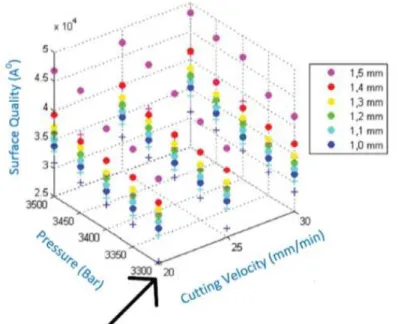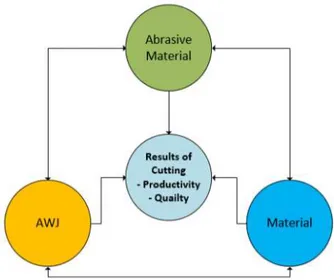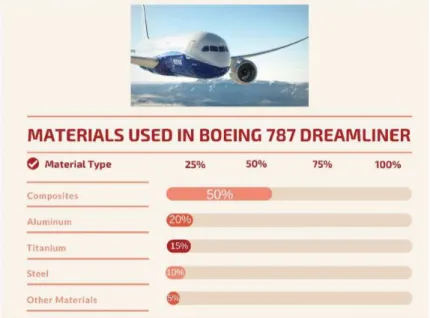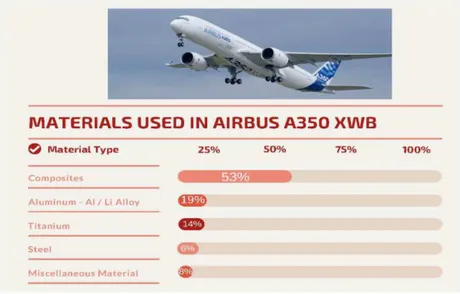ABRASIVE WATER JET (AWJ) APPLICATIONS IN THE AVIATION INDUSTRY
Dr. TAMER SARACYAKUPOGLUAssistant Professor, Department of Aeronautical Engineering, Istanbul Gelisim University, Istanbul, Turkey
ABSTRACT
There are some conventional cutting techniques such as milling, turning and drilling machines while there’s Abrasive Water Jet (AWJ) as a modern one. As a unique process, AWJ has been increasingly using in the aviation industry for more than four decades. AWJ allows cutting of various materials, from soft materials to brittle materials, from ceramic materials to composite. The aviation industry is known with usage of different types of materials such as the aforementioned types. With the processing of these raw and stock materials parts became as “flying parts” which are called as “airworthy or airborne parts” Aircraft can only fly with airworthy parts and machining them requires very stiff manufacturing system. Because of its competitive environment and high technology requirement, the aviation industry requires a fast, precise and cost-effective production processes. International Civil Aviation Organization (ICAO) sets the rules and regulations as the most successful specialized organization of the United Nations, the national and international airworthiness authorities have to obey the rules of ICAO. The reason why AWJ rapidly gaining a place within the aviation industry is that the material cutting efficiency is high and most of the time there is no need for secondary operations after cutting and the quality of the end product is generally inside the limit. The analyses performed during and after cutting, demonstrate that the Heat Affected Zone (HAZ) does not occur. Also, not occurring of thermal load is accepted as one of the advantages of AWJ. The objective of this paper is to provide the information regarding the usage of AWJ cutting technology which provides many advantages in the aviation industry. Besides, the conclusion of experiment studies of author’s doctoral thesis of some secondary data is also used in the paper. In this way, it is aimed to create a situational awareness for the employees of industrial companies and academicians regarding AWJ usage in the aviation industry.
KEYWORDS: Abrasive Water Jet (AWJ), Aviation Industry, Airworthiness & Aircraft
Received: Jun 05, 2019; Accepted: Jun 28, 2019; Published: Oct 29, 2019; Paper Id.: IJMPERDDEC201929
1. INTRODUCTION
It is a well-known issue that the aviation industry has been actively pioneering the usage of advanced materials and modern manufacturing techniques. E.g., the aviation industry was the earliest adopter of carbon fiber reinforced polymers (CFRP), and it was the first to integrate Computer Aided Design/Computer Aided Manufacturing (CAD/CAM) into its process (Stratasys, 2017). AWJ had started in 1830’s before the aviation industry. It developed itself rapidly and found a large field in the aviation industry. In the beginning, there were some conventional cutting processes like sawing, machining, etc. In time, the requirements have changed in accordance with the aviation industry. Now, AWJ is accepted as one of the most advanced cutting technologies (Andrzej, 2016). The aviation industry is a strategic high-tech industry which reflects a country's overall technological robustness and the overall industrial level (Fei Ma, 2016). A case study by Airbus et al. shows that the airline traffic doubles every 15 years (Airbus, 2017) will continue to do so regarding with the International Civil Aviation Organization’s (ICAO) 2016 capacity and efficiency report (ICAO, 2016).
O
ri
g
in
a
l A
rt
ic
le
ISSN (P): 2249–6890; ISSN (E): 2249–8001 Vol. 9, Issue 6, Dec 2019, 347–356 © TJPRC Pvt. Ltd.
So, what would be the impact of the implementation of the new, novel and digitalization in the aviation industry. In accordance with the PWC’s “2016 Global Industry 4.0 Survey, Industry key findings report” the expected digitalization impact is −3.7% of costs and +2.7% of revenues annually (PwC, 2018). At this point, AWJ is accepted as numerically controlled, modern technology which is preferred by aircraft constructing companies. e.g., Boeing, which is a leading aircraft manufacturing company makes 5-axis AWJ machine, a standard machine because during the cutting operation AWJ prevents delamination, splitting and edge scratches and provides accuracy in operation while saving time (Xue Shengxiong, 2017).
Reducing the weight is another issue for AWJ usage in aviation industry. Since, AWJ allows the manufacturer to produce parts of CFRP and other composites, it has a wide usage. The lighter aircraft means, less fuel burning, the ability of higher payloads carrying and longer ranges. Besides, weight reduction provides environmental benefits through reduced emissions and engine noise. There are many samples of the co-relation of AWJ usage as a novel technology, weight reduction, benefits to aircraft manufacturers and airliners. E.g., thanks to the weight reduction studies in Boeing, Boeing 777-300 has improved its fuel economy against Boeing 767-300 and managed to take off up to 368 passengers compared to 269 passengers in Boeing 767-300ER (M.R. Mansor, 2019). Reducing one pound of weight from each aircraft of a 600+ fleet of commercial aircraft could save about 11,000 gallons of fuel annually (Deloitte, 2014). The reduction of one kg built-in aircraft weight is able to reduce carbon emissions by 0.94 kg for the case of the Boeing 747-400 whose maximum take-off weight is 396,890 kg and by 0.475 kg in the Airbus A330-300 whose maximum take-off weight is 242,000 kg (Wen-Hsien Tsai, 2014).
2. RESEARCH STATUS
In this paper, aircraft manufacturing market projections will be provided, so, the size of the market will be figured out. The conclusion will be caught that, this huge market needs to integrate the novel technologies like AWJ for reducing the costs and gaining advantaged over competitors. Other than market size, the information regarding the AWJ technical features will be provided. After these secondary data, the optimization of information of the pressure, cutting velocity and diameter of water jet will be provided. Author demands to create a situational awareness over the usage and benefits of AWJ especially in the aviation industry. For sure, there are some constraints whereas considering the trade-off between advantages and disadvantages AWJ process will find likely a wider usage area in the aviation industry in the future.
Also advanced materials like composite materials have an increasing usage in the airplane manufacturing industry. The benefits of using the composite material are high strength-to-weight ratio, advanced resistance-to-corrosion, improved resistance-to-fatigue and hence lower airframe maintenance costs (Hale, 2006). Airframes of the airplanes are generally made from aluminum and steel. The density of steel is about 7.7–8.0 g/cm3, aluminum and its alloys is about 2.7 g/cm3 (M.R. Mansor, 2019), whereas the density of the typical density of CFRP is about 1.6 g/cm3 (Larissa Gorbatikh, 2016).
Therefore, about advanced materials and modern manufacturing methods which are used in aviation industry will be provided while monitoring the aircraft manufacturing market with numbers. Surface roughness is an issue and narrow-tolerances are necessary in aviation industry that’s why AWJ is must especially for large scale structural parts.
3. METHODS
3.1 AWJ History, Philosophy and Interactions
Usage of AWJ goes at the beginning of the 19th century. At that time, AWJ was used by Russian engineers especially for mining activities (Zhongwei Huang, 2018). After mining, AWJ has found a large field for other cutting operations. In the aviation industry, the materials which are used for airborne parts are quite expensive and for those parts mechanic loads and thermal loads are unwanted phenomenon. Heat Affected Zone (HAZ) is an unwelcome phenomenon which affects the “not-cheap aviation grade material’s crystal structure”. While cutting the materials with AWJ, there are no thermal loads and mechanic loads (Tarek M. Ahmed, 2018). If the material has a thick section or requires ‘no HAZ’ or is made from copper or a similar material that is highly reflective to some laser wavelengths, then AWJ may be more suitable cutting technique (Folkes, 2009). With the optimization of cutting parameters, the surface quality could be better. An experimental doctoral study by Saraçyakupoğlu et al. (2012) shows that optimization of the pressure, cutting velocity and diameter of water jet, effects the quality of surface. This optimization for BS 7191 355 EMZ and ASTM A516 Gr.60 steels is shown in figure 1. With the decreasing of cutting velocity and with the smaller water jet diameter the surface quality is increasing. Both of these materials are used for constructing of hydroplanes.
Figure 1: Comparison of BS 7191 355 EMZ and ASTM A516 Gr.60 Steels (Saracyakupoglu, 2012).
In this context, it can be claimed that, decreasing the cutting velocity increases the surface quality (Paul Etchells, 1997). It is worth noting that like all other machining process AWJ has its own interactions. Abrasive material quality is an important one, while the material will be cut and AWJ equipments are the other interactions. These items directly affect the result. The most of time surface roughness and the operation time are the outputs of the interactions. In Figure 2, interactions between abrasive particle, AWJ and material are depicted.
Figure 2: Interactions of AWJ Process (N.S. Guo, 1993). 3.2 Advantages and Disadvantages of AWJ
With the benefit of advantages and capability of high-quality surface, AWJ has found a vast usage in the aviation industry. Cutting of large composite materials, as well as metallic ones, makes AWJ a popular technique. Machining the large parts like wing, tail and skin parts on the aircraft is a trend requisition of enlarging aviation industry. During the production phase, each part and component must be carefully machined to the highest possible quality, as even the slightest error or structural weakness could lead to serious accidents or incidents (Cutting, 2019). Such as all technological process AWJ also has some advantages as shown in figure 3.
3.2 Comparison of Awj with Other Cutting Techniques
AWJ is a unique cutting process. In terms of surface quality, it is observed that AWJ provides more sensitive surface comparing with cutting with gas and cutting with plasma as it is depicted in Figure 4. Before progressing to market volumes of airplane constructing companies the usage of materials such as aluminum and composite must be investigated.
Figure 4: Comparison of AWJ with Other Cutting Techniques (Akkurt, 2014). 3.3 Airplane Constructing Companies Material usage
What aviation industry was doing decades ago has now become a regular application for other industries like automotive, white-goods, etc. Since the competition is fierce reducing the flight operation cost is an important objective of airliner companies. Some weight reduction studies were presented in the introduction section. The weight reduction means a lot in the name of operational cost. Weight optimization is possible with the usage of Carbon Fiber Reinforced Polymers (CFRP) materials. The density of polymer composites typically half of the weight of aluminum and one-fifth of that of steel (M.R. Mansor, 2019). Evolving the parts from aluminum or steel to polymers reduces the operational cost. Leader aircraft manufacturer companies like Boeing and Airbus are focusing on material change. In Figure 5, the material spectrum of Boeing 787 Dreamliner is shown.
Using composite materials in Boeing 767 is even higher than Boeing 787 Dreamliner with the percentage of 77% (Xue Shengxiong, 2017). In Figure 6, it is shown that composite materials which are used for Airbus A350 XWB about 53%.
Figure 6: Materials used in Airbus A350 XWB (A. Katunin, 2016). 3.4 Cutting Process of Materials in the Aviation Industry
The parts which are used in above-mentioned aircrafts vary in size from large parts such as bulkheads, longerons, supports, wings and fuselage sections to small size parts such as brackets, clips, and door stringers. AWJ is the most suitable cutting methodology for having the parts to End-of-Part (EOP) borderline (Hashish, 2013). For example, Airbus A310’s vertical stabilizer (8,3 m. high by 7,8 m. wide at the base), a major aerodynamic and structural member fabricated in its entirety from carbon composite with a total weight saving of almost 400 kg when compared with the Al alloy material previously used.
Besides, the CFRP fin box comprises only 95 parts excluding fasteners, compared with 2076 parts in the metal unit (Soutis, 2005). Another important AWJ in the aviation industry is cutting of honeycomb materials which are too fragile for cutting using with CNC machining cutters. Since low forces applied to the work piece during machining, AWJ enables fragile materials to be cut without distortion or breakage (Kulekci, 2002). Cutting velocity is very important during the cutting process of CFRP with AWJ. In Figure 7 it is shown that unsatisfactory cutting happens as the velocity is lower or higher than the optimum value.
Figure 7: Sections with Lower or Higher of Optimum Value of Cutting Velocity (Moeller, 2010).
4. AIRCRAFT PRODUCERS AND THEIR MARKET VOLUMES AT THE GLOBAL SCALE
Having ability of manufacturing a part or component for airplane constructing business requires Product Organization Approval (POA). With the recent market reports, the aircraft manufacturers that dominate the global aviation market which have POA accreditations are the companies such as Boeing (US), Airbus (European Union), COMAC (China-Russian), Bombardier (Canada), Embraer (Brazil), ATR (France) and some others.
In the commercial aircraft market, until 2037 approximately 161.500 new aircraft will be delivered globally to replace retired aircraft and support the development of airliners. In table 1, the key player aircraft manufacturers manufacturing projects are submitted.
Table 1: The Projection of the Market-Dominating Aircraft Manufacturers between 2018– 2037
Aircraft Manufacturer Number of Aircraft
Boeing 42.730 (Boeing, 2018)
Airbus 37.400 (Airbus, Global Networks Global Citizens, 2018-2037, 2018) Comac 42.702 (Comac, 2018)
Bombardier (2017-2036) 25.100 (Bombardier, 2018) Embraer 10.550 (Embreaer, 2018) ATR 3.020 (ATR, 2018)
Total 161.502
In the general evaluation, approximately 161.502 passenger aircraft will be produced until 2037. There are some other small sized aircraft manufacturer companies in the aircraft manufacturing market and the number will be more than the total number given above. This huge market makes mandatory of having ‘certified sub-contractors& subsidiaries’ in the aviation industry. The companies which hold POA certifications audit their sub-contractors such as AWJ companies with the stiff rules and regulations of airworthiness authorities.
5. CONCLUSIONS
The aviation manufacturing industry is a strategic high-tech industry which reflects a country's overall national strength and the overall industrial level (Fei Ma, 2016). Also it is a highly engineered science, requires both flight and ground safety and that’s what stringent airworthiness requirements are for. International Air Transport Association (IATA) declares that 8.2 billion people will fly in 2037 means that there’s an increasing demand from customers for flying more frequently at the global stage (IATA, 2018).
In this paper, it is aimed to create a situational awareness of the AWJ application in the aviation industry with the size of the airplane constructing market. This traffic makes the aviation industry a field of ‘hard game’. Staying robust in the manufacturing market, forces the companies for producing the parts faster, more precise and more cost-effective.
Because of the demand for lowering the operations costs, weight reduction studies will always be while maintaining the strength properties of the materials. The lighter aircraft means cheaper operational costs and lower CO2
emissions. That’s why in the future the parts will be exchanged with the lighter ones as soon as they meet the safety requirements. At that point AWJ will be used in the aviation industry for large scale or small size parts which are used with lighter materials like CFRP, polymers, aluminum alloys, etc. Optimization of pressure, cutting velocity and water jet diameter gives opportunities to have more precise surfaces. While bringing the borders of the parts to EOP, AWJ is the
most suitable cutting process since the wastage is almost ignorable and surface quality is high. AWJ is a mature process being used safely in the aviation industry and it will be a subject which grows rapidly at the global level.
REFERENCES
1. Katunin, K. K. (2016). Concept of a Conducting Composite Material for Lightning Strike Protection. Advances in Material Science, 33.
2. Airbus. (2017). Growing Horizons Global Market Forecast. Airbus. 3. Airbus. (2018). Global Networks Global Citizens, 2018–2037.
4. YASSA, R. I., & IKATRINASARI, Z. F. Determination of multi-item inventory model with limitations of warehouse capacity and unit discount in leading garment industry in Indonesia. International Journal of Mechanical and Production Engineering Research and Development, 9(2), 161–170.
5. Akkurt, A. (2014). Experimental Investigation Of The Surface Properties Obtained By Cutting Brass-353 (α+β) With An Abrasive Water Jet And Other Cutting Method. Materials and Technology, 727.
6. Andrzej, P. (2016). Abrasive suspension water jet cutting optimization using orthogonal array design. International Conference on Manufacturing Engineering and Materials (s. 1). Nový Smokovec, Slovakia: Procedia Engineering. 7. ATR. (2018). Turboprop Market Forecast 2018–2037.
8. Boeing. (2018). Commercial Market Report 2018–2037.
9. Bombardier. (2018). Commercial Aircraft, 2017–2036 Market Forecast.
10. Youssef, S. I. A. M., & Rowıhıl, M. S. Impacts of Clımate Change on Oceans and Coasts, Basıc Physıcal and Chemıcal Phenomena Influence on Bıologıcal Processes and Fısh Stocks whıle Consıderıng the Challenges and Prospects for the Marıtıme Industry.
11. Comac. (2018). Market Forecast Report (2018-2037).
http://english.comac.cc/news/latest/201811/14/t20181114_6610546.shtml adresinden alındı.
12. Cutting, H. t. (2019, 06 28). Precision Waterjet & Laser. http://www.h2ojet.com/news/how-the-aerospace-industry-uses-waterjet-cutting adresinden alındı.
13. Deloitte. (2014). 3D opportunity in aerospace and defense. A Deloitte series on additive manufacturing. Deloitte University Press.
14. Embreaer. (2018). Market Outlook Report 2018–2037.
15. Fei Ma, W. C. (2016). The Review of Manufacturing Technology for Aircraft Structural Part. 9th International Conference on Digital Enterprise Technology, (s. 1). Belfast, Ireland.
16. Folkes, J. (2009). Waterjet—An innovative tool for manufacturing. Journal of Materials Processing Technology, 6. 17. Bandela, N., & Kosey, S. Mathematıcal Modellıng for Water Qualıty of Nathsagar Reservoır, Aurangabad.
18. Hale, J. (2006). Boeing 787 from the Ground up. Boeing AERO Magazine, s. 17–23. www.boeing.com. adresinden alındı 19. Hashish, M. (2013). Trimming of CFRP Aircraft Components. WJTA-IMCA Conference and Expo, (s. 1).
20. IATA. (2018). Forecast Predicts 8.2 billion Air Travelers in 2037. www.iata.org/pressroom/pr/Pages/2018-10-24-02.aspx adresinden alındı
21. ICAO. (2016). Capacity and Efficiency Report, 2016–2030 Global Air Navigation Plan. International Civil Aviation Organization.
22. Kulekci, M. K. (2002). Processes and Apparatus Developments in Industrial Waterjet Applications. International Journal of Machine Tools & Manufacture, 5,6.
23. Larissa Gorbatikh, B. L. (2016). Hierarchical lightweight composite materials for structural applications. Cambridge MRS Bulletin, 1.
24. M. R. Mansor, A. N. (2019). Natural fiber polymer composites: utilization in aerospace engineering. E. F. Deepak Verma içinde, In: Biomass, Biopolymer-Based Materials, and Bioenergy: Construction, Biomedical, and other Industrial Applications (s. 220). Woodhead Publishing, Elsevier.
25. Mert, T. (2012). Water Jet Cutting Technology and its Comparison with other Cutting Methods in Some Aspects. Academic Journal of Science, 280.
26. Moeller, R. (2010). Machining of CFRP with Water-Jets in Aerospace Industry. F. A. Activity (Dü.). içinde, (s. 27). http://www.iom3.org/sites/default/files/iom3-corp/wed%201555%20moller.pdf adresinden alındı
27. N. S. Guo, H. L. (1993). Surface Structure and Kerf Geometry in Abrasive Water Jet Cutting Formation and Optimization. 7th American Water Jet Conference, Volume I. Seattle.
28. Paul Etchells. (1997). Cutting Head Design Lowers Abrasive Waterjet Cutting Costs. Aircraft Engineering and Aerospace Technology, 69(2), 150.
29. PwC. (2018). Industry 4.0: Building the digital enterprise Aerospace, defence and security key findings. PwC.
30. Saracyakupoglu, T. (2012). Analysis of Material, Pressure, Cutting Velocity and Water Jet Diameter’s Effect on the Surface Quality for the Water Jet Cutting. Practical doctoral dissertation, 102–120.
31. Soutis, C. (2005). Fibre reinforced composites in aircraft construction. Progress in Aerospace Sciences, 7.
32. Steven M. Arnold, D. C. (2012). Materials selection for aerospace. National Aeronautics and Space Administration (NASA). 33. Stratasys. (2017). Additive Manufacturing Trends in Aerospace.
34. Alkadı, B. T., & Ghafoor, A. A. Derıvatıon Of Spatıally Dıstrıbuted Unıt Hydrograph For Balısan Valley Watershed Usıng Gıs And Remote Sensıng Technıques.
35. Tarek M. Ahmed, A. S. (2018). Improving Surface Roughness of Abrasive Waterjet Cutting Process by using Statistical Modeling. CIRP Journal of Manufacturing Science and Technology, 1.
36. Wen-Hsien Tsai, Y.-C. C.-J.-C.-Y. (2014). A green approach to the weight reduction of aircraft cabins. Journal of Air Transport Management, 71.
37. Xue Shengxiong, C. Z. (2017). Introduction and Analysis of the Ultrahigh Pressure Water Jet Cutting Multifuctional Application. 2017 WJTA-IMCA Conference and Expo, (s. 2). New Orleans.
AUTHOR PROFILE
Assist. Prof. Dr. Tamer SARACYAKUPOGLU has been working in the aviation industry for more than 25
years. From 1994 to 2012 he served to Turkish Air Force. During his military service, he had many international experiences such as head of project control office in South Korea for KT-1T training aircraft project from 2009 to 2010, being the member of DLM steering group of NAPMA, Holland and being a member of Global Sustainment Group of Joint Strike Fighter (F-35) program. During his academic career, he has experience in lecturing abroad such as Montenegro University, Kyrenia University, and Kuwait Airways.
From 2012 up to now he has been working as academician. Today, he is an academician at Istanbul Gelisim University, Aeronautical Engineering Faculty. He teaches aviation lessons.
He has a book on sale in the international market and articles published in the “International Journal of Innovative Science and Research Technology”, “American Journal of Aerospace Engineering” and Turkish Academic journals. He is also an editorial board member of “International Journal of Aerospace and Mechanical Engineering”. After his graduation from the pilot training school in 2014, he also gained the flex-wing pilot license and UAV commercial license.
He mainly focuses on additively manufactured parts, especially their usage in the aeronautical industry.
At present, Assist. Prof. Dr. Tamer SARAÇYAKUPOĞLU enjoys flying as well as writing articles and books related to the aviation industry.




